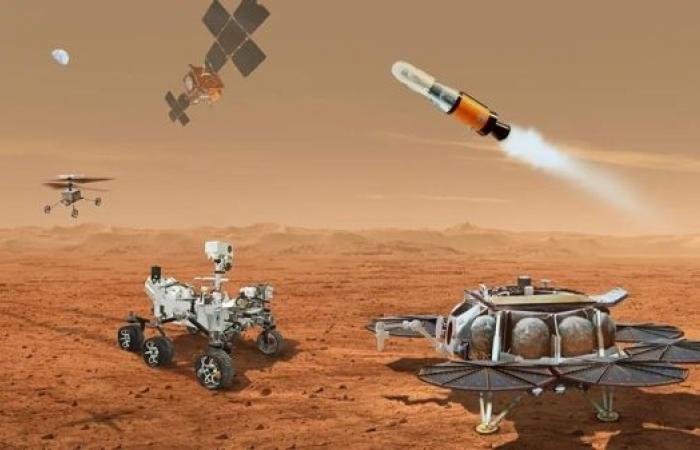We show you our most important and recent visitors news details Nasa says new plan needed to return rocks from Mars in the following article
Hind Al Soulia - Riyadh - WASHINGTON — The quest to return rock samples from Mars to Earth to see if they contain traces of past life is going to go through a major overhaul.
The US space agency says the current mission design could not return the materials before 2040 on the existing funds and the $11bn (£9bn) to make it happen sooner is not sustainable.
Nasa is going to canvas ideas for a cheaper, faster alternative.
It hopes to have a solution on the drawing board later in the year.
Returning rock samples from Mars is regarded as the single most important priority in planetary exploration, and has been for decades.
Just as the Moon rocks brought home by Apollo astronauts revolutionised our understanding of early Solar System history, so materials from the Red Planet are likely to recast our thinking on the possibilities for life beyond Earth.
But Nasa now acknowledges the way it's going about achieving the samples' return is simply unrealistic in the present fiscal environment.
"The bottom line is that $11bn is too expensive, and not returning samples until 2040 is unacceptably too long," Nasa administrator Bill Nelson told reporters in a Monday teleconference.
The former US senator said he would not allow other agency science missions to be "cannibalised" by the Mars project.
He is therefore seeking fresh thinking from within Nasa and from industry.
The Mars Sample Return, or MSR, program is a joint endeavour with the European Space Agency (Esa).
The present architecture is already in play, in the sense that the rock samples to be returned home are in the process of being collected and catalogued on Mars today by Nasa's Perseverance rover.
A dedicated follow-up mission was due to be launched later this decade that would carry a rocket to the surface of the Red Planet.
Once loaded into this ascent vehicle, Perseverance's samples would then be blasted skyward to rendezvous with a European-built spacecraft that could catch them and head for Earth.
It was envisaged that roughly 300g of Martian material would land in a capsule in the western US state of Utah in 2033.
But an independent review that was reported in September last year found faults with the way the mission design was being implemented. It doubted the schedule could be maintained and, even if it could, the cost was likely to balloon to somewhere between $8bn and $11bn.
In its response published on Monday, Nasa doesn't disagree with the assessment — hence the desire now to re-open discussion on the best way forward.
"We are looking at out-of-the-box possibilities that could return the samples earlier and at a lower cost," said Dr Nicola Fox, the director of Nasa's science directorate.
"This is definitely a very ambitious goal, and we're going to need to go after some very innovative new possibilities for design, and certainly leave no stone unturned."
Those new possibilities could include a smaller, simpler rocket, she said.
Dr Fox told BBC News that Esa remained central to the endeavour. Indeed, it's likely Europe's significant contribution — the Earth Return Orbiter (ERO) — will still be launched, albeit at a slightly later date than currently envisaged, possibly in 2030.
Dr Orson Sutherland, Esa's Mars exploration group leader, said his organisation would meticulously review Nasa's response plan.
"Our priority remains ensuring the best path forward to achieve MSR's ground-breaking scientific objectives and lay the groundwork for future human missions to Mars," he said.
Nelson emphasised that Nasa remained totally committed to MSR.
It needed, however, to fit within a sustainable budget envelope, which he described as somewhere between $5bn and $7bn.
The overwhelming scientific imperative behind MSR was underlined in recent days by the latest investigations of Perseverance.
The robot is working in a wide crater called Jezero, which looks to have held a large lake about 3.8 billion years ago — a highly promising scenario for the existence and preservation of microbial organisms.
Perseverance has been drilling and caching rocks that appear to have been laid down at the margin of the lake.
One of the rover's senior scientists, Prof Briony Horgan from Purdue University, said these samples were particularly exciting.
"Right now onboard Perseverance, we're carrying three samples of silica and carbonate-cemented rocks, and on Earth, both of those minerals can be fantastic for preserving ancient signatures of life," she told BBC News.
"We think it's possible that some of the samples are sandstones laid down in the ancient lake, but are still evaluating other origins as well. Either way, these rocks are the exact types of samples that we came to Mars to find, and we very much want to get them back to our labs on Earth." — BBC
These were the details of the news Nasa says new plan needed to return rocks from Mars for this day. We hope that we have succeeded by giving you the full details and information. To follow all our news, you can subscribe to the alerts system or to one of our different systems to provide you with all that is new.
It is also worth noting that the original news has been published and is available at Saudi Gazette and the editorial team at AlKhaleej Today has confirmed it and it has been modified, and it may have been completely transferred or quoted from it and you can read and follow this news from its main source.





